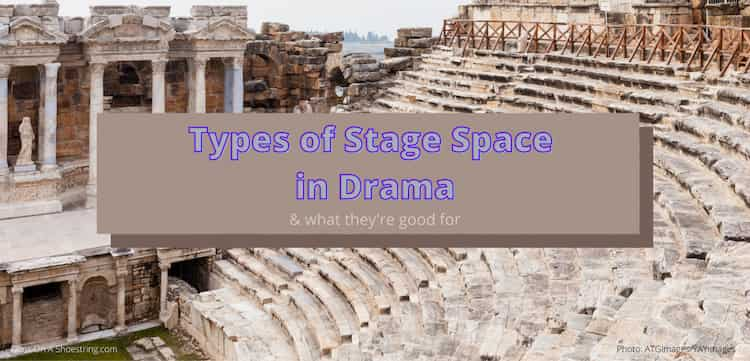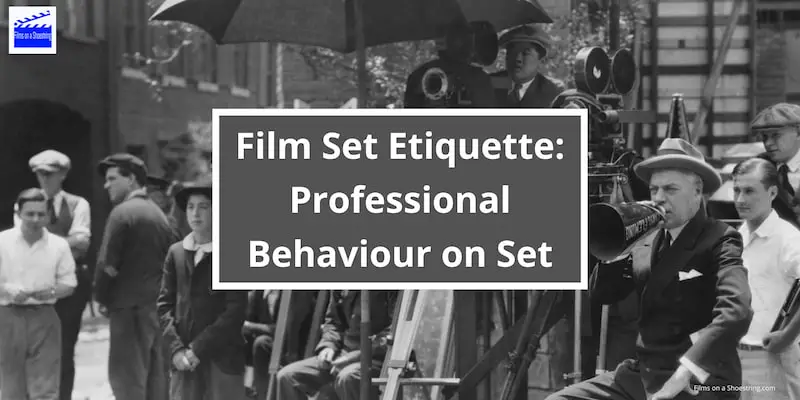Wondering about the types of stage space and what they are good for? Perhaps you’re unclear why all stages aren’t the same – or maybe thought every professional stage is like the traditional one found in Victorian era theatres.
Several types of stage space in drama settings are commonly in use today, even across the professional theatre companies. Each impacts what the audience sees, hears and experiences during the performance.
Whatever your role as a theatre maker, you should understand how the type of theatre space changes the acting, directing, lighting, and set building.
Examples of different types of stage
Nicholas Acciani introduces some of the types of stage in use today. See how the different types of stage look and where the audiences sit. Find out why the stage type affects the way theatre pieces are planned and performed.
Why do you need to know which type of stage you’re working on?
The stage type you are working on demands a particular style of
- Acting
- Directing
- Lighting
- Set building
Proscenium theatre stage
The Proscenium theatre stage is the traditional form of theatre stage. The stage has a frame around it, called the proscenium arch. The audience all face the stage from the front. It’s the theatre stage you’ll usually find in older theatres, high schools and even Broadway.
The proscenium arch is often decorated with decorative patterns and statues to enhance the theme of the play. Sometimes a set of stairs to one side of the front of the proscenium allow actors to move between the stage and the audience. In the UK, this is a common feature for pantomime.
The orchestra pit sits just under the front of the proscenium stage, mostly hidden by a small screen. The conductor watches the action on stage and directs the musicians in time with the live action.
Using a Proscenium Stage
Because the audience sits at the front, and usually some distance from the stage, actors, directors and crew plan accordingly.
Actors can only look at other characters for brief moments of time when they speak. Otherwise, the audience loses much of the visual emotion and clarity of speech. So framed by the proscenium arch stage actors spend a lot of time gazing out of the acting area towards the audience as they speak.
Directors focus on what the audience sees from the front, and direct action and movement accordingly.
Lighting designers and set builders plan according to the view from the front. If you’re creating the illusion of a drawing room wall, for example, only the front needs perfecting. The audience doesn’t see it from another angle.
Proscenium stages are good for creating scenes that look good from one direction only. That is an efficient way to plan a production, especially one which is touring several venues.
Apron Theatre Stage
An apron is a small stage on a raised platform sited in front of the proscenium stage. It’s often a slightly different height to the proscenium, with actors moving between the two stage areas. The audience watches from the front, unless the apron is converted into a thrust stage.
Apron stages are movable platforms with have movable feet. They are mainly popular in settings with movable seating. Traditional theatres from a century ago have fixed seating so often struggle to accommodate apron stages.
An apron stage is usually bare. At the most, there’s just a few props to hint at the setting.
Using an Apron Stage
An apron stage bring actors a bit closer to the audience. That can add dramatic effect for powerful scenes. The actor’s performance should subtly change with this increased intimacy.
Allowing actors to increase the acting space and move between two stages allows a sense of freedom. You can sense the change of location, time, or character perspective.
Platform Stage (Black Box Theatre)
A platform stage is a stage with no proscenium, or frame. It might have a stage wall added to allow wings for actors and crew. Most are flexible and movable, while a few aren’t. It’s the form of staging often associated with music concerts and open air performances.
It’s often known as a Black Box stage, or Flexible Stage. The seats can be moved into different places. So it can be made into a thrust stage, or an arena stage.
A platform stage can be good for flexible spaces where there is no traditional stage. It raises the performance above ground level so the audience’s view is better. A primary feature of platform stages is their simplicity and flexibility.
Flexible or foldable stages are often used to stage small-scale or alternative theatre, for performances that require less stage space than a traditional theatre.
Using a Platform Stage
A platform stage is positioned with both location and audience in mind. Its flexibility allows audience seating to be positioned according to creative goals within individual settings.
What the space needs for the production, like staging, lighting and sound require many more specific details.
If there’s only a small studio space, the platform stage can go in a corner with access to a door or screened backstage area. The audience views the play from two sides. Or in a larger venue, the platform stage can sit in the centre of the audience as long as the movement on stage is directed for four different viewpoints.
Thrust stage
A thrust stage has audience seating around three sides and has no back wall. A thrust stage is a rectangular shape which can extend out of a proscenium stage, or be standalone. The audience’s view includes the sides and backs of actors as they move around.
Actors will block someone’s view throughout the performance, no matter which parts of the stage they use. It takes careful direction to consider the audience’s view when it comes from three different sides of the stage.
Lighting design for a thrust stage is important, because there’s no one point which is the front of the stage. If you light up one side of the stage too brightly, the light shines into the eyes of the audience rows sitting opposite.
Using a Thrust Stage
Actors are close to, and surrounded by, the audience. That increases intimacy and connection.
Serving three different audience views enhances the need for continual movement between characters, which can be used to good effect. It’s a great place for action.
The lack of stage scenery means scant props, carefully designed costumes and actor’s use of the open stage must create the imagined location in the audience’s minds. So done in the right way, that can be great for the production budget and give the freedom of any setting according to the needs of the play.
Arena Stage
An arena stage is also known as theatre in the round. It can be a round stage, square, rectangular, or other shape. The key feature is that the seating goes all around the stage area, with entry and exit points between the stage and the backstage area.
While large music arenas are designed for large scale music performances and lavish productions, the arena stage for drama produces a small and intimate setting for audience engagement.
Arena theatres are sometimes found in drama schools, such as the one at Rose Bruford College. More commonly, flexible seating is used to create an arena theatre in any performance space, such as a village hall or studio theatre. Theatre in the round can even be set up on a traditional stage, with the actors and audience sharing the proscenium stage together.
Using an Arena Stage
Because an arena stage is seen from all sides, there is no stage scenery to create beyond a few simple (and portable) props. That can be great for your production budget.
In small settings, the close proximity between audience and actors creates an intimate space. From the audience’s view, it fells like they are sitting in the imagined room with the characters, rather than watching action happening from outside. But such stages need their actors to follow carefully designed stage direction for movement. You want each audience member seeing and hearing the emotions playing out.
Open Air Theatre
An Open Air theatre refers to the space where the play takes place without the protection of a building around it. These structures can be of various forms and sizes, depending on the size of the venue, with room for a stage and audience members.
An open air stage can be built outdoors or erected indoors as a temporary venue. The size and form of an open air theatre can be traditional or dynamic, depending on the particular circumstances of the production.
In The Globe in London, audience members paying a higher price to sit in seats also benefit from some roof cover, though the building is not fully roofed. However, most theatre that takes place in the open air is without any cover from sun, wind or rain.
The type of stage chosen for open air theatre depends on the space available and the nature of the production. A theatre in the round in a park is ideal for one of Shakespeare’s plays. West End musicals are better suited to a large platform theatre with the audience sitting at the front.
Using an Open Air Stage
There are many challenges to using an open air stage for a theatre performance. Set building must consider the effects of the weather from the outset. Lighting and sound design has new challenges to overcome. Actors must throw their voices to the furthest end of the audience without losing clarity of their sentences or doing damage to their vocal chords. Getting used to this very different acting space requires a lot of tailored rehearsal.
But open air stage performances are often the ones the audience will remember the best. They are fairly rare, and a very different experience to sitting in a theatre.







